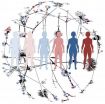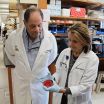(Press-News.org) People lie – we know this. People lie to kids – we know this, too. But what happens next? Do children who've been lied to lie more themselves?
Surprisingly, the question had not been asked experimentally until Chelsea Hays, then an undergraduate student in psychology at the University of California, San Diego, approached professor Leslie Carver with it. Now the pair have a paper out in Developmental Science, suggesting that adult dishonesty does make a difference, and not in a good way.
"As far as we know," said Carver, associate professor of psychology and human development in the UC San Diego Division of Social Sciences. "This is the first experiment confirming what we might have suspected: Lying by an adult affects a child's honesty."
The study tested 186 children ages 3 to 7 in a temptation-resistance paradigm. Approximately half of the children were lied to by an experimenter, who said there was "a huge bowl of candy in the next room" but quickly confessed this was just a ruse to get the child to come play a game. The others were simply invited to play, with no mention of candy.
The game asked children to identify character toys they couldn't see by their sounds. Sounds and toys were pretty easy to pair: a "Tickle me" audio clip for Elmo; "I love cookies" for Cookie Monster; and "There is a rumbly in my tummy" for Winnie the Pooh. One sound was a deliberately tricky exception: Beethoven's "Fur Elise," which is not associated with any commercially available character toy.
When the classical music cue was played, the experimenter was called out of the room to, supposedly, take a phone call – leaving the children alone in the room for 90 seconds and tempting them to take a peek at the mysterious toy making that sound. The children were explicitly asked not to peek. On returning, the experimenter also explicitly asked the children to tell the truth. Cameras rolled the whole time.
And? The 5-, 6- and 7-year-olds who had been lied to were both more likely to cheat and then more likely to lie about having done so, too.
About 60 percent of the school-aged children who had not been lied to by the experimenter peeked at the tricky temptation toy – and about 60 percent of the peekers lied about it later. Among those that had been lied to, those figures rose to nearly 80 percent peeking and nearly 90 percent of the peekers lying.
"Why?" remains an open research question, Carver and Hays note in their paper. It could be the 5- to 7-year-old children were simply imitating the behavior modeled by the adult, or it could be they were making judgments about the importance of honesty to this adult. Or, it could be more nuanced: "Perhaps," they write, "the children did not feel the need to uphold their commitment to tell the truth to someone who they perceived as a liar."
But it didn't seem to make any difference to the younger set, the preschoolers, whether they had been deceived by the experimenter earlier. They peeked and lied at about the same rates. That may be because 3- and 4-year-olds don't have very sophisticated theory-of-mind abilities yet.
The study was not designed to get at the reasons that children are more likely to lie when they have been lied to, but to demonstrate that the phenomenon can occur, Carver said.
What happens when trusted care-givers do the lying also remains an open research question. But Carver and Hays are still urging restraint. Even if it's expedient for an adult to lie – to get cooperation through deception, for example, or to get children to control their emotions – it's probably a bad idea in the long run.
Earlier research, Carver and Hays note in the paper, has documented that the majority of parents admit to lying to their children even as they maintain that honesty is an important value.
"The actions of parents," Carver and Hays write, "suggest that they do not believe that the lies they tell their children will impact the child's own honesty. The current study casts doubt on that belief."
INFORMATION:
The study has implications not only for parenting but also for teaching scenarios and for forensic situations, said Carver: "All sorts of grown-ups may have to re-examine what they say to kids. Even a 'little white lie' might have consequences."
Lied-to children more likely to cheat and lie
2014-03-19
ELSE PRESS RELEASES FROM THIS DATE:
Small step towards growing tissue in the lab
2014-03-19
University of Adelaide mathematicians have devised a method for identifying how cell clusters have formed by analysing an image of the cluster.
Published in the Journal of Theoretical Biology, their mathematical modelling tool will be useful in helping biologists and tissue engineers to move towards growing human tissue such as liver in the laboratory.
"When any tissue or organ develops, the cells have to organise themselves into the correct structure," says Dr Edward Green, researcher in the University's School of Mathematical Sciences. "This self-organisation process ...
Ancient DNA shows moa were fine until humans arrived
2014-03-19
A study by Curtin University researchers and colleagues from Denmark and New Zealand strengthens the case for human involvement in the disappearance of New Zealand's iconic megaherbivore, the moa - a distant relative of the Australian Emu.
All nine species of New Zealand moa, the largest weighing up to 250 kilograms, became extinct shortly after Polynesians arrived in the country in the late 13th century.
Researchers have previously suggested, from limited genetic evidence, that huge populations of moa had collapsed before people arrived and hence influences other ...
No-refrigeration, spray vaccine could curb diseases in remote areas
2014-03-19
DALLAS, March 19, 2014 — A new kind of single-dose vaccine that comes in a nasal spray and doesn't require refrigeration could dramatically alter the public health landscape — get more people vaccinated around the world and address the looming threats of emerging and re-emerging diseases. Researchers presented the latest design and testing of these "nanovaccines" at the 247th National Meeting & Exposition of the American Chemical Society (ACS), the world's largest scientific society.
Their talk was one of more than 10,000 presentations at the meeting, being held here ...
Understanding binge eating and obesity
2014-03-19
VIDEO:
In this JoVE video article, a set of methods to measure food-related motivation and values are described in JoVE's peer-reviewed video article format.
Click here for more information.
March 19, 2014 —Researchers at the University of Cambridge have developed a novel method for evaluating the treatment of obesity-related food behavior. In an effort to further scientific understanding of the underlying problem, they have published the first peer-reviewed video of their technique ...
101 liver cancer drug candidates pave the way to personalized medicine
2014-03-19
The heart disease drug perhexiline is one of 101 compounds predicted to prevent cancer growth in most patients suffering from our most common liver cancer, HCC. This is an outcome from a novel simulation-based approach using personal sets of proteins of six HCC patients.
"This is the first time personalized models have been used to find and evaluate new potential drugs," says Professor Jens Nielsen at Chalmers University of Technology.
--
Our most common liver cancer, Hepatocellular carcinoma, HCC, causes more than half a million deaths worldwide every year. If the ...
Gut bacteria can cause life-threatening infections in preterm babies
2014-03-19
Babies born prematurely are surviving in increasing numbers. But many withstand complications of early birth only to suffer late-onset sepsis — life-threatening bloodstream infections that strike after infants reach 72 hours of age.
While early-onset sepsis often is caused by pathogens acquired from the amniotic sac or birth canal, the causes of late-onset sepsis have been far less clear.
But now, researchers at Washington University School of Medicine in St. Louis have discovered that preterm babies' guts harbor infectious microbes that can cause late-onset sepsis.
The ...
Drinking alcohol several times a week increases the risk of stroke mortality
2014-03-19
Consuming alcohol more frequently than twice a week increases the risk of stroke mortality in men, according to a study carried out at the University of Eastern Finland. The results show that the effects of alcohol are not limited to the amount consumed, but also the frequency of drinking matters. The results were published in Acta Neurologica Scandinavica on 8 March.
Excessive consumption of alcohol is associated with a variety of different diseases. The relationship between alcohol consumption and ischaemic stroke shows a J curve pattern, which means that in people ...
GPS also helps to analyze global water resources
2014-03-19
This news release is available in German. FRANKFURT. WaterGAP (Water Global Assessment and Prognosis) is a hydrological model used to model water shortage, groundwater depletion, and floods and droughts (e.g. as impacted by climate change) over the land area of the globe. The Frankfurt hydrologist Prof. Petra Döll has examined how good a fit this model provides, using GPS observations and data from the GRACE satellite, which measures the gravitational field of the Earth. The study, published in the current issue of the scientific journal Surveys in Geophysics indicates ...
Rewrite the textbooks on water's surface tension
2014-03-19
Researchers from the University of Melbourne and University of Sydney are confident their new reaserach results will make significant differences to the calculations of surface tension of water used by the next generation of atmospheric scientists, biophysicists and engineers of technology like inkjet printers.
These latest investigations have clinched a long-standing controversy amongst the physical Chemistry community; the air-water interface is negatively charged by the adsorption of hydroxide ions.
Prof Angus Gray-Weale from the Chemistry, Department of Chemistry ...
Ottawa researchers find new pathway connected to type 2 diabetes
2014-03-19
Ottawa, ON, March 19, 2014 — Scientists at the Children's Hospital of Eastern Ontario (CHEO) Research Institute have discovered a cellular pathway that is responsible for keeping blood sugar levels low in obese or pre-diabetic people, and may prevent the onset of Type 2 diabetes. The discovery published this month in a leading journal Nature Cell Biology.
Following a meal, beta cells found in islets of the pancreas secrete insulin that helps to store food energy for future use. The inability of islet beta cells to produce enough insulin leads to diabetes. Unlike other ...





